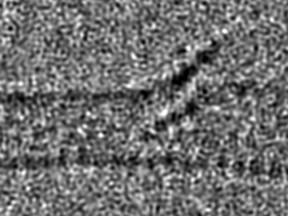Home > Press > 'Seeing' molecular interactions could give boost to organic electronics
 |
| High-resolution transmission electron microscopy can be used to visualize a certain type of organic molecular interaction at the atomic level. CREDIT: Kyoto University's Institute for Integrated Cell-Material Sciences (iCeMS) |
Abstract:
Organic materials are increasingly being applied in cutting-edge technologies. Organic semiconductors, for example, are being used to develop paper-thin, plastic LED screens.
'Seeing' molecular interactions could give boost to organic electronics
Kyoto, Japan | Posted on July 28th, 2015Materials scientists need to understand the structures and physical properties of organic materials at the atomic level to optimize the efficiency and increase the life span of devices that incorporate them.
Previously used techniques for this purpose have had their limitations although high-resolution transmission electron microscopy (HR-TEM) has recently successfully been used to visualize the structures, movements and reactions of single, small organic molecules.
Now, for the first time, a team of researchers from Kyoto University's Institute for Integrated Cell-Material Sciences (iCeMS) and Japan's National Institute of Advanced Industrial Science and Technology together with colleagues from Finland's Tampere University of Technology has successfully used HR-TEM to visualize a certain type of organic molecular interaction at the atomic level.
They linked pyrene, a hydrocarbon composed of four flat benzene rings, to a single-walled carbon nanotube that the researchers used as a scaffold for this purpose. They then used HR-TEM to see the link.
"This same methodology can be used to study any organic molecules that contain an aryl group," says Tomokazu Umeyama, the study's lead investigator. An aryl group is a group of atoms derived from benzene by removing a hydrogen atom. "The methodology has the potential to provide indispensible information regarding molecular interactions," he says.
###
The study was published on July 15, 2015 in Nature Communications.
####
For more information, please click here
Contacts:
Tomoka Aiyama
81-757-539-755
Copyright © Institute for Integrated Cell-Material Sciences, Kyoto Unive
If you have a comment, please Contact us.Issuers of news releases, not 7th Wave, Inc. or Nanotechnology Now, are solely responsible for the accuracy of the content.
| Related News Press |
News and information
![]() Simulating magnetization in a Heisenberg quantum spin chain April 5th, 2024
Simulating magnetization in a Heisenberg quantum spin chain April 5th, 2024
![]() NRL charters Navy’s quantum inertial navigation path to reduce drift April 5th, 2024
NRL charters Navy’s quantum inertial navigation path to reduce drift April 5th, 2024
![]() Discovery points path to flash-like memory for storing qubits: Rice find could hasten development of nonvolatile quantum memory April 5th, 2024
Discovery points path to flash-like memory for storing qubits: Rice find could hasten development of nonvolatile quantum memory April 5th, 2024
![]() Good as gold - improving infectious disease testing with gold nanoparticles April 5th, 2024
Good as gold - improving infectious disease testing with gold nanoparticles April 5th, 2024
Display technology/LEDs/SS Lighting/OLEDs
![]() Utilizing palladium for addressing contact issues of buried oxide thin film transistors April 5th, 2024
Utilizing palladium for addressing contact issues of buried oxide thin film transistors April 5th, 2024
Chemistry
![]() What heat can tell us about battery chemistry: using the Peltier effect to study lithium-ion cells March 8th, 2024
What heat can tell us about battery chemistry: using the Peltier effect to study lithium-ion cells March 8th, 2024
![]() Nanoscale CL thermometry with lanthanide-doped heavy-metal oxide in TEM March 8th, 2024
Nanoscale CL thermometry with lanthanide-doped heavy-metal oxide in TEM March 8th, 2024
Nanotubes/Buckyballs/Fullerenes/Nanorods/Nanostrings
![]() Tests find no free-standing nanotubes released from tire tread wear September 8th, 2023
Tests find no free-standing nanotubes released from tire tread wear September 8th, 2023
![]() Detection of bacteria and viruses with fluorescent nanotubes July 21st, 2023
Detection of bacteria and viruses with fluorescent nanotubes July 21st, 2023
Discoveries
![]() Chemical reactions can scramble quantum information as well as black holes April 5th, 2024
Chemical reactions can scramble quantum information as well as black holes April 5th, 2024
![]() New micromaterial releases nanoparticles that selectively destroy cancer cells April 5th, 2024
New micromaterial releases nanoparticles that selectively destroy cancer cells April 5th, 2024
![]() Utilizing palladium for addressing contact issues of buried oxide thin film transistors April 5th, 2024
Utilizing palladium for addressing contact issues of buried oxide thin film transistors April 5th, 2024
Announcements
![]() NRL charters Navy’s quantum inertial navigation path to reduce drift April 5th, 2024
NRL charters Navy’s quantum inertial navigation path to reduce drift April 5th, 2024
![]() Discovery points path to flash-like memory for storing qubits: Rice find could hasten development of nonvolatile quantum memory April 5th, 2024
Discovery points path to flash-like memory for storing qubits: Rice find could hasten development of nonvolatile quantum memory April 5th, 2024
Interviews/Book Reviews/Essays/Reports/Podcasts/Journals/White papers/Posters
![]() Simulating magnetization in a Heisenberg quantum spin chain April 5th, 2024
Simulating magnetization in a Heisenberg quantum spin chain April 5th, 2024
![]() Discovery points path to flash-like memory for storing qubits: Rice find could hasten development of nonvolatile quantum memory April 5th, 2024
Discovery points path to flash-like memory for storing qubits: Rice find could hasten development of nonvolatile quantum memory April 5th, 2024
|
|
||
|
|
||
| The latest news from around the world, FREE | ||
|
|
||
|
|
||
| Premium Products | ||
|
|
||
|
Only the news you want to read!
Learn More |
||
|
|
||
|
Full-service, expert consulting
Learn More |
||
|
|
||








